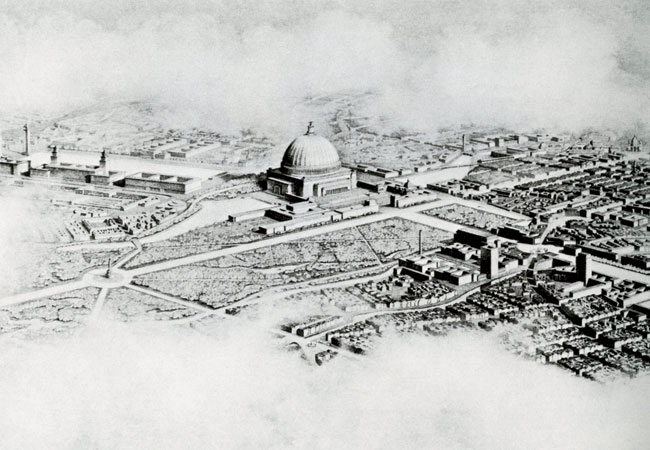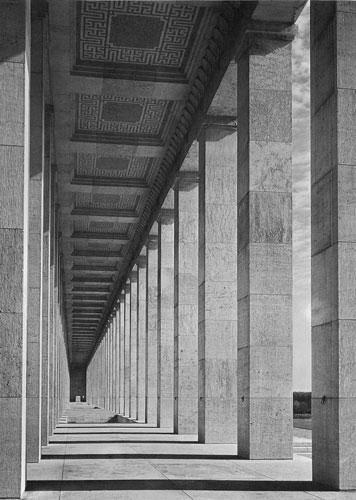Albert Speer: Architecture 1932-1942


















Designing the First Axis of Evil
Leon Krier would like us to look at the Nazi architecture of Albert Speer in a detached manner. But he starts painting himself into a corner on the very first page. He decries the widespread opinion that Nazi architecture is “worthless, however well-designed.”
Let's stipulate that Speer, Hitler's architect and also the Third Reich's minister of armaments and war production, manipulated scale, proportion, columns, and entablatures with great facility—not to mention prodigiousness—and that the documentation of Speer's output is of interest. There are even moments I dare call sublime, but they are few. It's mostly crushingly heavy and funereal. (The intimately involved Hitler may have known things would end badly.)
Can Nazi architecture ever be deemed “well designed”? Should we ever allow ourselves to be “detached” about Nazi architecture?
Krier gushes and swoons, taking particular delight in the vast “archetypically benevolent” dome over the Great Hall that would have dominated the Berlin skyline. It is made maternally nurturing by its resemblance to a woman's breast. The ways in which he is offensive quickly add up.
As I look at the vast north-south axis that Speer would have carved through Berlin, all I can find is architecture unique only in its gigantism. Every detail reminds people of their insignificance and the necessity of their fealty in the face of the power of the world-conquering state. (Berlin's most beautiful examples of classicism, the Museum Island and the Gendarmenmarkt, are urban pinpricks in comparison to Speer's grandiosity.)
His freeway-size boulevard might have sped bureaucrats from palatial ministry to palatial ministry, but in contrast to, say, Baron Haussmann's Paris, there is no urbanity. I can imagine Krier scandalized if even a brightly colored caf' awning besmirched the purity of Speer's unending pageantry of columns, pilasters, and prancing statuary utterly disconnected from the messy city it has hacked through.
Turning paranoid, Krier argues that the real enemy is Modernism. Modernists fell under the spell of industrialism, which doomed truly humanistic, craft-made classicism. And damned if Hitler didn't suffer from the same hallucination! “Industrial technology ... imposed its own totalitarian rule,” Krier sputters, a “dictatorship [that] would prove more fatal to the destiny of humanity as a whole than Hitler's despotism.”
He completely ignores the Modernist intention to use industrial techniques to deliver a healthful urbanism for all, in contrast to the fetid, overcrowded slums—however quaint their street facades—that were the dominant lot of Berliners and other urban dwellers before Modernism and social-welfare policies delivered good housing to many.
Even Speer, in a foreword prepared for the book's original 1985 edition, seems less deluded than Krier. Speer, who died in 1981, wrote that Nazi architecture was not merely a symbolic backdrop, but “an integral part of the movement.”
It would be easy to dismiss Krier as a gadfly. (And why did Robert A.M. Stern write a foreword to this drivel?) But then I think of Philip Johnson filing approving dispatches from the gigantic 1930s Nazi rallies designed by Speer. Under a night-sky cathedral created by upwardly aimed searchlights, heaving seas of people punched the air with Nazi salutes amid ranks of waving swastika flags—consolidating a mass-hysterical myth of unbounded power.
James S. Russell is the architecture critic at Bloomberg News and author of The Agile City.












